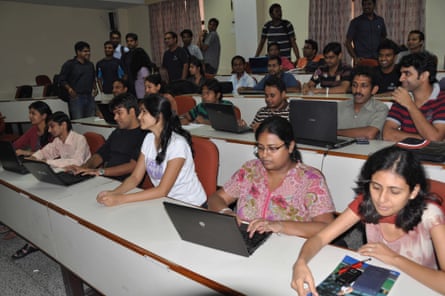It is time to be “open about the science of human nature”. This was the assertion of software engineer James Damore to his colleagues at Google, in an internal memo that has since led to his sacking. “I’m simply stating,” Damore wrote, “that the distribution of preferences and abilities of men and women differ in part due to biological causes and that these differences may explain why we don’t see equal representation of women in tech and leadership.” He went on to imply that women’s “stronger interest in people” and “neuroticism” might make them less naturally suited to being coders at Google.
The company’s leadership viewed the matter differently, firing Damore and sparing his female colleagues the need to prove their biological aptitude for working with computers.
Sacking one errant employee doesn’t alter an awkward fact, though. Only 20% of Google engineers are women – a statistic that is matched roughly across big tech companies. So, does Damore have a point? Is there an underlying biological explanation for why so few women work at a company that prides itself on its progressive ideals and family-friendly ethos?
There are countless scientific studies that claim to identify differences between male and female cognitive aptitudes and, in the UK, far fewer girls choose to study computer science at GCSE level (20% of the total number of students), at degree level (16%) and beyond. There is something seductive about the idea that professional success springs from our innate abilities, rather than the degree to which society tips the odds in our favour.
After the contents of the memo became public, through a leak to tech site Gizmodo, the “scientific” argument for innate biological differences quickly found favour with some tech insiders, albeit those writing anonymously on sites such as Hacker News and the gossip app Blind.

On Blind – which requires users to prove who they work for before posting – one Google employee wrote: “Can we go back to the time when Silicon Valley were [sic] about nerds and geeks, that’s why I applied [to] Google and came to the US. I mean this industry used to be a safe place for people like us, why so fking complicated now.” “I used to dislike conservatives until I started working in tech,” wrote another. “Now I sympathise with them due to the hostility and groupthink, as well as the fact that they are the only ones standing up for classical liberal values.”
While the biological hypothesis seems to appeal to some tech workers, the notion that Silicon Valley’s gender gap can be explained away by such factors is questionable. Prof Dame Wendy Hall, a director of the Web Science Institute at the University of Southampton, points to the wide variation in gender ratios in computing internationally, which she argues would not be seen if there were a universal biological difference in ability between the sexes. While only 16% of computer science undergraduates in the UK – and a similar proportion in the US – are female, the balance is different in India, Malaysia and Nigeria.
“I walk into a classroom in India and it’s more than 50% girls, the same in Malaysia,” says Hall. “They are so passionate about coding, Lots of women love coding. There just aren’t these gender differences there.”
In fact, in the west, female participation in computer science has plunged since the mid-80s, while female participation in medicine and other scientific fields has increased steadily.
Over the past decade, even with a number of initiatives being set up to boost girls’ participation in coding and computer science, the proportion of female computer science undergraduates has continued to fall – 10 years ago, the proportion was 19% of the UK total.
Hall believes that the gender gap and the “male computer geek” stereotype can be dated back to the advent of the home computer in the early 80s, when the machines were marketed heavily as gaming systems for men. She suspects this might be more culpable for women’s low participation than men having evolved a mindset better suited to writing lines of code.
“Women were turned off computing in the 80s,” she says. “Computers were sold as toys for the boys. Somehow that cultural stigma has stuck in the west in a way that we can’t get rid of and it’s just getting worse. The skills gap is going to get huge.”
Jane Margolis, a psychologist at the University of California, Los Angeles, agrees. Margolis interviewed hundreds of computer science students in the 90s at Carnegie Mellon University, which had one of the top programmes in the country at the time.
“Many of the women at Carnegie Mellon talked about computers being in [their brother’s] bedroom and there were a lot of father-son internships around the computer that weren’t happening with the girls,” she says. “There was a cultural assumption that the norms of being in computer science were that you would do it 24/7, were obsessed with it, wanted nothing in your life but computers – and that was very much associated with male adolescents,” she added. “It was very much based around a male norm. Females were made to think that, if they didn’t dream in code and if it wasn’t their full obsession, they didn’t belong or were not capable of being in the field.”

Prof Gina Rippon, a neuroscientist at Aston University in Birmingham, has studied extensively cognitive differences between men and women. She says that, while Damore pointed to scientific evidence for men and women having different aptitudes and personality traits, he “seemed to miss the point that, even if there were well-established sex differences at any level, they’re always very tiny. Certainly not enough to explain the gender ratios of Google programmers – even if you didn’t want to get into the nitty-gritty of arguing about the science.”
Rippon’s work suggests that, in many cases, the differences between male and female performance, if present, are very small, can disappear with training and are not consistent across cultures.
In one study, Rippon found that British men performed significantly better on a spatial rotation task than women. However, when the experiment was repeated with Chinese participants, there was no difference between the male and female participants. Other similar studies have found that gender differences in spatial rotation tasks disappeared when the researchers controlled for video game experience. Rippon points to another study, which showed that differences in personality traits between men and women varied wildly across countries, depending on the status of women in that society.
So, Damore’s suggestion that women are “more prone to anxiety” does not imply that this difference is a function of hormones or hardwiring of the brain. Plus, there is compelling evidence that unconscious biases have a powerful effect on what people expect themselves to be good at and how they perform. For instance, girls tend to score worse on a test if they are told their maths skills are being assessed than when they are told they are taking part in a study investigating how people solve problems.
Even assuming that there are fundamental differences between male and female cognition and personality, there is no clear, logical line between such findings in a laboratory setting and performance in the workplace.
Priya Guha, the UK lead of tech incubator RocketSpace and a former UK consul general in San Francisco, argues that, even by its own arguments, Damore’s memo missed the point. “The description of an engineer as somebody who has their head down, focused on developing the next line of code, is the sort of engineer that won’t be adding value,” she says. “We need engineers out there who are both very strong developers, but also people who understand the world around them and are comfortable interacting with society. So, by that description, women would be better engineers even by the stereotypes he proposes.”
Unfortunately, many such multiskilled people are likely to be deterred by the perception of hostility engendered by claims like Damore’s. “We have a historical challenge to encourage girls, let alone women, into careers such as engineering, which then creates an imbalance in the people who enter tech industries overall,” says Guha. “Tech has a particular problem in this area. Wherever there are instances of people creating a hostile environment, companies need to stamp that out quickly. His dismissal sends a really powerful message: the environment in these companies needs to be thought about to ensure that it improves day by day.”
But Eileen Burbidge, a partner at venture capital firm Passion Capital, argues that tech does not have a significantly worse gender gap than other high-pressure industries such as finance or the media. “I think it comes down to cultural norms and female representation in general,” Burbidge says. “It is what affects the rest of the business world: it’s around the same time that women start thinking about having families that they think about the opportunity cost of staying in a work environment, and if it’s not positive or they get negative influences it’s going to affect their decisions.”
She argues that, in many ways, tech is better placed than most large industries to tackle its gender gaps. “I don’t think there’s anything specific that needs to be done for technology: I think the tech sector is more introspective and likes to think of itself as more progressive, so remedies that work for other sectors will help here, too,” she says.
“In Stem [science, technology, engineering and mathematics] in particular, we’re seeing the tech industry trying to be more proactive about outreach. The industry is trying to have this discussion a lot – companies don’t always follow what they say, but they say it, at least.”

Peter Daly, an associate in the employment team at the law firm Bindmans, agrees with Burbidge. “The clients I’ve had from the tech world are pretty evenly split by gender,” he says. “But, because it encourages risk-taking, tech doesn’t fit well with maternity and pregnancy, so that can be a source of a lot of friction. You see people in the industry who see pregnancy as a genuine problem.” That, he says, is the main cause of gender-specific issues in technology – at least, those that reach the stage of requiring a legal recourse.
Internal documents such as Damore’s are the soft end of the sort of hostile working environment female employees can face at overwhelmingly male tech firms. At the extreme end, as companies such as Uber and Tinder have learned, this environment can result in claims of sexual harassment and illegal discrimination.
At Uber, where 85% of technical employees are male, one engineer, Susan Fowler, wrote a tell-all blogpost that revealed a workplace where managers proposition female employees for sex and human resources does little to stop the issue. Tinder faced a similar scandal when former VP Whitney Wolfe sued the company over “atrocious” misogyny in 2014, entering into evidence abusive texts allegedly sent by Tinder’s chairman, Sean Rad.
Beyond the egregious cases, the wider culture of even the most diverse Silicon Valley firms can still end up being offputting to would-be employees: the campus-style culture, which encourages workers to be on site from dawn till dusk, renders it hard for any primary caregiver to be “part of the team”, while in some companies an antipathy for part-time work or on-site creches can also limit flexibility.
Addressing the gender gap isn’t only an issue of perception. Companies with homogenous workforces make worse products and earn less money, argues Guha. “We know large numbers of women are struggling to get funding. A female founder is 86% less likely to be funded than a man,” she says. “That’s crazy when we know the return on investment is higher; it is about 34% higher for companies with a gender diverse leadership. It’s not about ‘corporate social responsibility’: a diverse range of thinking will bring better value for the company.”
As we move into a future in which algorithms have greater influence on our lives – from communication to healthcare, transport to the law – the gender balance in tech companies goes beyond what is fair for their employees. The result of male domination of tech has led to the development of, for example, voice recognition technologies that, trained and tested solely by men, struggle to understand female voices. It has resulted in virtual reality technologies that disproportionally impose motion sickness on women. At this early moment in its history, the tech industry is already littered with products that have gender bias effectively programmed into them.
“The most objectionable point about that memo was the notion that there are biological differences that make women less capable,” said Burbidge. “Obviously, I have an issue with that and I think it’s fundamentally incorrect. The thing I can’t answer is how, in 2017, do you stop people thinking that? I don’t know how you change people’s minds.”
“As we go into the world of AI, when people are designing algorithms that help us live our lives, it will be very bad if that’s all done by men,” says Hall. “Social care, looking after kids, so many aspects of our lives. We really need as many people as possible doing this. It’s really important and it’s going to get more important.”
Hall invokes her late mentor Karen Spärck Jones, a pioneering British computer scientist who campaigned hard to encourage more women into the field. As she used to say: “Computing is too important to be left to men.”

Comments (…)
Sign in or create your Guardian account to join the discussion